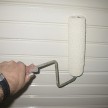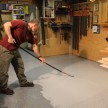How to Prep For Painting
Painting Preparation
“Preparation When Painting Is Everything!!” . . . . . says my friend and fellow craftsman Mark O’Lalor of O’Lalor Painting Company. Mark has graciously agreed to write today’s post.
Photo: Mark O’Lalor [repairing recessed ceiling holes]
Photo: Mark O’Lalor
The Importance Of Preparation
In the professional circles of Painting Contractors there is a long standing acknowledgement that even a good paint job requires great preparation. In fact, after working as a Painting Contractor for over ten years I have come to conclude that the entire field of painting should be renamed to emphasize the fact that most of the work that we do is preparing a surface for paint.
Painting is the easy part and probably takes up only thirty percent of the actual work performed on any given project.So perhaps I should call myself a Preparation Contractor.
Most Common Reason A Paint Job Fails
There are many examples that illustrate the importance of great preparation.The most common is paint failure that is caused when a painting contractor fails to simply lightly sand and wash a surface prior to painting.
Most people would guess that the sanding and washing is only necessary on the trim surfaces.This makes sense since trim surfaces are the surfaces that people come in contact most.However, oils from the human hand, ambient dust in the interior and exterior environment, oil rich cooking vapor, candle wax vapor and of course dust from construction all contribute to create a barrier between the applied paint and the surface in question. These substances all need to be washed off to ensure proper adhesion.
Photo: Massive paint adhesion failure.
Plaster Dust Kills A Paint Job
The truth is that it does cost more up front to do proper preparation but it definitely pays for itself in the long run. Recently I came across a costly paint failure that is the easiest to avoid: Paint failure due to painting over plaster dust.
Washing The Walls Is Important
On new construction projects General Contractors try to minimize costs and sometimes take the lowest cost painting proposal.As a result corners are cut and the simple act of washing down the newly plastered walls is skipped.In fact, freshly plastered walls should not only be thoroughly washed but they should be treated with not just one but two coats of latex primer prior to the final top coat.
These pictures show a seven year old condominium remodel that was recently painted.My job was to paint doors that the Concord Carpenter installed. Afterall the construction was complete we came in and started to prep for paint. The first thing I noticed was that in several places where blue tape had held up the plastic Zip wall [dust door] the paint had peeled up completely exposing bare plaster.I have seen this often enough to know that this was a serious problem.
Photo: Shows bare plaster under paint peelings. No primer was present.
Photo: Mark O’Lalor removing large sections of failed paint from wall.
After notifying the client we began to lightly scrape to test the limits of the failure. The strips of paint were coming off so easily and in such large segments that not only do I believe it was not simply washed but I think the original painting company skipped the primer and just painted the walls.
Two to three inch patches of paint were coming off as I was scraping. My remedy to repair and what I feel is the best method of repair was to completely scrape off the remaining paint on the two small walls in the kitchen that are situated in a high traffic area. In the living room I cut a line with a window scraping tool about a foot and a half away from the corner of the kitchen access wall.
Poor preparation = Penny wise Pound foolish.
I believe the living-room wall is similarly compromised but since all the furniture is in place and paintings are hung there will be minimal disturbance and the paint should stay in place.
This is a situation where you have to balance budget and the question; “Where do we stop?”
To hide the jagged painted edge I created when I scraped off the compromised paint I will lightly sand the paint edge, wash the wall I scraped and put two coats of primer on the bare plaster.
Once the primer is fully cured I will skim coat to the painted edge with joint compound to “feather in” the repair. Once the joint compound is fully cured I will double prime and repaint the corner feathering in the paint to the existing painted surfaces.
As with anything in life you have to pick your battles. I believe scraping off all the compromised paint was the most cost effective choice for the homeowner. Trying to patch the small areas that failed that are surrounded by a sea of failure is a fools errand.
7 – P’s of Painting
The bottom line is that preparation is key to painting.
A fun way to summarize my point is to suggest that my fellow craftsmen follow the 7 P’s of Painting:
PROPER-PRUDENT-PREPARATION-PREVENTS-PISS-POOR-PAINTING.
~ Mark O’Lalor.








